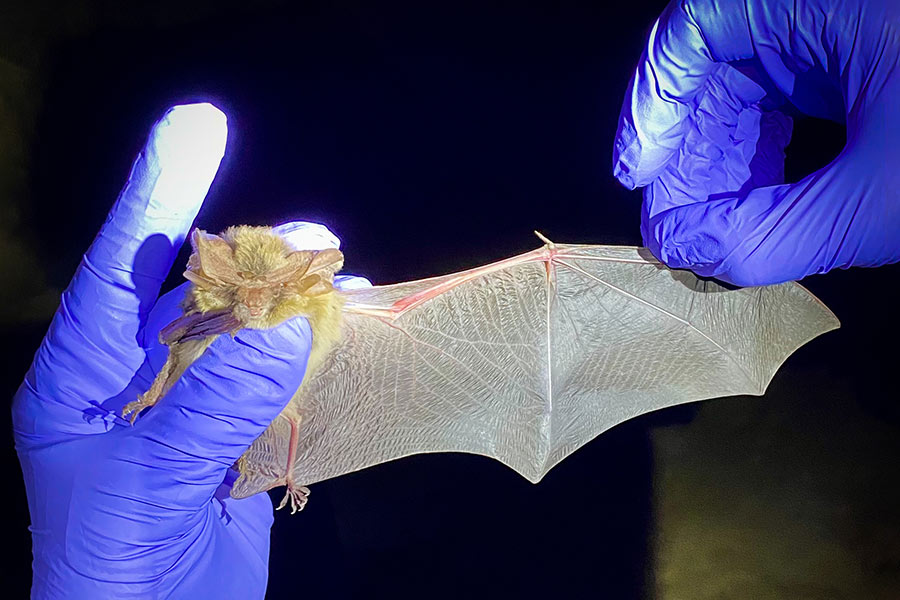White-nose syndrome
White-nose syndrome is a disease that affects hibernating bats. It was first detected in New York State in 2007–08. Since then, the disease has spread to over 40 states and caused up to 100% mortality in some bat hibernacula. The causative fungus was first found in Utah in Canyonlands National Park in 2024. See a map of the current distribution of WNS.
The disease is caused by the cold-loving fungus Pseudogymnoascus destructans. The fungus invades the skin of hibernating bats, causing tissue damage. It can be visible on the nose, ears and wings as a white, fuzzy coating. Infected bats exhibit higher levels of activity during hibernation which leads to a premature expenditure of winter fat reserves and causes the bat to leave the hibernacula early in search of food. The bats ultimately starve or freeze to death.
Many species of North American bats are highly vulnerable to this fungus with twelve species confirmed with diagnostic symptoms of WNS. A large decline in Northern long-eared and tricolored bat populations in eastern North America led to them begin listed under the Endangered Species Act.
While the fungus that causes white-nose syndrome has been detected in Utah, there remains many unknowns about how the disease will affect our bat populations. Potentially, all hibernating bat species in Utah could be susceptible to WNS. The big brown bat (Eptesicus fuscus) and little brown bat (Myotis lucifugus) which are common in Utah, have been infected elsewhere. Also of concern are the Yuma bat (Myotis yumanensis), long-eared bat (Myotis evotis), fringed bat (Myotis thysanodes), long-legged bat (Myotis volans), California bat (Myotis californicus), western small-footed bat (Myotis ciliolabrum) and canyon bat (Parastrellus hesperus). There are many differences between western North America and the more eastern areas where WNS was first detected and most research has occurred. The number of bats observed in caves and mines in western North America are small, and the location of most western bat populations in the winter is unknown. From the limited studies that have located western bat hibernacula, a pattern is emerging of dispersed hibernation in crevices, as opposed to the large congregations in caves observed in many eastern populations.
Bat-to-bat and bat-to-environment-to-bat transmission are believed to be the primary ways the fungus is spread, but human-assisted transmission is also possible. The fungus can be transported on boots, clothes and other gear. Pets can also transport the fungus on their fur. The severe effects of WNS on bat populations justifies taking precautions to reduce the risk of human-assisted transmission and minimize any disturbance to hibernating bats.
Multiple efforts are underway to determine how the spread of WNS can be prevented and the disease treated or cured. These efforts involve states, provinces, tribes, federal agencies, universities, conservation organizations and local communities. Those collaborative efforts are essential to bat conservation. Reducing the risk of human-assisted spread of the fungus and avoiding activities that disturb bats during their critical hibernation periods are key to this effort.
Within Utah, the Division of Wildlife Resources collaborates with many partners to advance bat conservation through the Utah Bat Conservation Collaborative. The DWR conducts annual surveillance for the fungus, monitors bat populations and works to protect bats and their roosts.
What can you do?
- If you find a dead or sick bat between January and April, please contact the Utah Division of Wildlife Resources.
- Avoid entering caves, mines and other areas that are used by bats to prevent the spread of WNS and to avoid disturbing roosting bats.
- If you used any gear or equipment in a mine or cave in a WNS affected area, do not use it in Utah or any other unaffected areas.
- If you visit a subterranean bat roost, you should clean and treat your clothing and gear regardless of the season or the time of year following the National WNS Decontamination Protocol.


